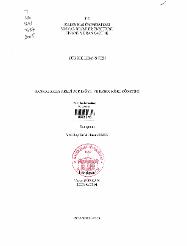| dc.description.abstract | The banks, established on economic system, are important institutions that providework of economy through collecting and distributing funds. The banks, acting in the creditmarket that is sensitive, exercise vital function in national and international level. Also, theyhave inevitable role in general eceonomic policy.Commercial banks operate in short-term and long-term money market. The crediteffects on the firm is more vital than the amount in the balance sheet because of the marginalcharacteristic. The firms use short-term bank credit to finance workin capital needs, currentasset especially for inventories and/or receivables.Multinational baks carry competition to the markets they enter. Parallel to thiscompetition, turkish banks have made much harder profit than after multinational banks. Inthis competitive market, one of the main conditions to protect prfitability is to reach optimumproductivity via using their fund for creating effective credit portfolio.Risk management is quality control system in financial institutions. Risk managementnatural part of portfolio management. Intense studies about credit risk, that stil go on, havebeen made in recent years. Most of these studies, are still developing and far from practicalusage. However, the only common part all of these studies is that they comprise liquid anddeveloped market. There is no information for the behaviour of non-liquid and less developedcountries.In spite of the fact that there is risk management models and ways, the main progressfor financial institution is that form organizational and management structure. To collectnecessary information individually by banks is important for compettition.Parallel to this,past information quality become more important than before.The main aim of effective credit portfolio risk management is to increase the returnaccording to risk. Although, there are a lot of aims for each financial institutions, the first aimof these firms is to maximize the shareholders? return. Other three aims for credit portfoliomanagement are management concentration risk, lagal adaptation and increasing the return.Improving and increasing banking service affect credit evaulation of commercial andindustrial segment. Generally, credit portfolio?s quality and profitability is seen as the mainreason of the success or unsuccess of the bank. The main reason of most bank bankruptanciesis incorrect evaulation of credit risk?s return, wrong credit decision given without thefollowing necessary step of credit process. In spite of this, credit evaulation process does notbe examined in theory sufficiently in Türkiye. The banks have evaluated their creditapplication using classic credit analyse method, till now. Credit management make itsdecision according to each application and does not consider interrelation of credits or effectson total portfolio.In recent years, credit have been evaulated according to portfolio approach,interrelation of each other and effects on total portfolio. This way, banks try to decrease itscredit risk with reducing the ratio of default credit to total credit portfolio.Our work comprise theoric side and explain how credit portfolio form for commercialbanks and what the methods use for credit risk management. The aim is to maximize thereturn from banks funds while minimizing the risk.Parallel to our study result, it is very useful giving importance below points when thecommercial banks form thei credit portfolio and manage their portfolios. These are,ï · The banks should consitute effective and healty credit policy.ï · Banks should have talented and experienced credit analyst to exercise the bank creditpolicyAlso,it needs to form information mechanism for credit evaulation.It has toshorten information process and decrease the cost of credit evaulation .High costs ofcredit evaulation is caused to decrease the number of credit sort or bank specialize theless credit areas.All of these, decrease credit diversification?s benefit for banks.ï · Bank should use portfolio management approach with classic analyse and evaulationprocess when they constitute credit portfolio.ï · Credit manager sholud prevent incorrect decision to follow credit evaulation?sfundamental principle.ï · Portfolio plan should be made carefully. Portfolio plan aim to measure all varianceand co-variance of asset?s return. It is not useful to measure one credit risk or onecustomer risk in practise. This process needs to define the events or factors that hashuge effects on credit. These events or factors comprise of interest rate, exchange rate,growth rate, relative labour cost and price of goods.ï · When the credit decision is made, it isnecessary to consider which credit, to whom,how much is given and what the interest rate is for portfolio. The aim is to increase theeffectiveness of market and present high return and low risk product. Parallel to theseaims, when the bank managers determine the price, they consider the bank?s strategy,market and cost for their success.ï · If there are correlations between risks that is affected by one or more factors , weakcredit?s weight is more than others in portfolio plan process. These types of credit?sreturn show common movement and has potantial variety.ï · Portfolio is evaulated totally. Domestic and foreign credit policy must be coordinatedto each other and the bank must consider other bank risk simultaneously. Risk andcredit valueness common criterias must allow to compare any two credits.ï · Turkey, preparing to enter EU, give an importance to portfolio management in creditevaulation to compete in bankin sector. | en_US |
















